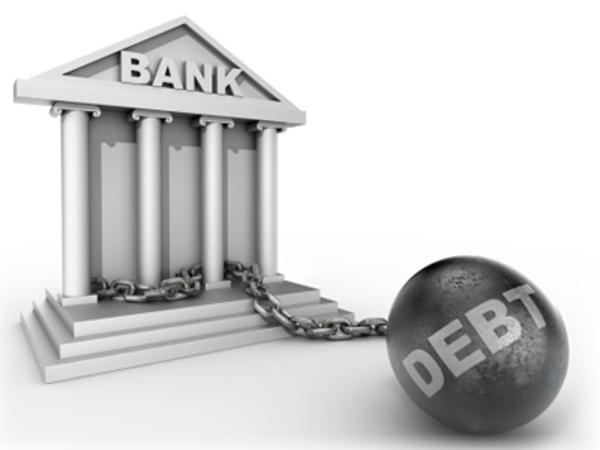PSU Banks drowning due to Bad Loans and Non Performing Assets – NPA.

Stock markets are sinking for last couple of months and biggest losers are the bank with their profits dropping up to 90% and more. All PSU banks are struggling high due to this and bank’s regulatory has warned all banks to improve on this else there might be tougher situation for the banks. All leading banks like SBI, PNB, BOI, BOB are struggling in this uncertain market situation. Biggest problem faced by banks is huge drops in profits due to much rise in NPA – Non Performing Assets.
Why Indian Banks have such high NPAs? Let us try to find how the banks work in India and why banks are not able to make profits out of it’s assets.
Asset-Liability from a bank’s perspective – If a person/company/entity borrows a loan, for him that loan is a liability which is to be repaid with the interest to the lender and all the deposits of the individual/company would be the assets asset. Opposite to this, from the bank’s perspective, all the money deposited by individuals/companies/establishments in savings account, current account and fixed deposits are liabilities from a bank’s perspective. It is because bank is liable to pay interests on these deposits ranging from 0% to 10%, even higher in some cases. When Bank lends loan to any person or company, bank earns 4% to 40% interest on that loan amount. So from a Bank’s perspective, the loans it has lent are its assets and the deposits it carries are its liabilities. Banks collect money from individuals and companies as deposits and pay them interests. Banks use this money (which belongs to others) to give various loans like home, automobile, business, education, personal and other on a higher rate of interest than the bank pay to deposits. Many banks offer credit cards to customers and money received by banks as bills of the cards is disbursed as various loans. This is the biggest source of revenues and profits for the banks.lly banks are paying interest for using that money. The difference between interest it earns from loans and the interest it pays to the depositors is called Interest Margin and is the primary source of Bank’s income. There are other sources too but, we would ignore them for this discussion.
NPA-Non Performing Asset – Banks lend money in the market to earn higher interest, but if any loan does not generate any interest or principal amount over a defined period, loan becomes non performing asset as banks stop getting revenues from that. Usually the period for an asset to declare NPA is 90 days since it generated last revenue for the bank. So an asset which was supposed to generate income for bank has stopped not only generating additional income for the bank but also its principle amount. This leads banks towards loss in profits and revenues and in such scenarios bank’s market position also drops. For example, a bank has Rs 500 as deposits from 5 different individuals and bank pays them Rs 4 each every year as interest. Bank keeps Rs 100 as statutory requirements and lends Rs 400 to 4 different people (Rs 100 each at 10% simple interest). Ideally these borrowers should pay Rs 10 each year as interest and pay back Rs 100 at the end of the loan period to the bank. So bank earns Rs 40 as interest, while pays 20, so its net interest earning is Rs 20. However what if any of the borrowers defaults? He stops the payment of Rs 10 and is also unwilling to return the principal amount of Rs 100. Now the bank, has not only lost opportunity to earn interest, it has also lost the 100 rupees, which belonged to the depositor. So Bank has 400 (deposit) + 30(interest earned) while it owes the depositors 500 (original deposit money) + 20 (interest to be paid to depositors). Hence bank straightaway loses Rs 90. This is just a simple example in few hundred rupees but when this figure reaches in several lakh crores in deposits versus loans versus NPA, the loss of bank rises in billions. Interests usually work compounded, are reducing and payable monthly along with principle amount known as the EMIs. So even if 5% of the borrowers start defaulting, the bank will be in a mess.
Why Indian Banks have such high NPA – Indian banks include public sector banks (banks owned by Central/State govt.), which face huge NPAs and private sector banks like ICICI, HDFC, Axis etc, which too have NPAs but they are fairly negligible compared to public sector banks. Usually the banks have a conservative credit policy which has many filters such as previous credit profile, if the loan seeker has defaulted in the past, his cashflow, i.e. if his future income is stable and reliable, if it is a secured loan, then if the property/asset on which loan is sought, has sufficient value so that bank can liquidate it if necessary and many such filters. Yet, despite this diligence, banks do have NPAs. However the question is why have the public sector banks like UBI, BI, SBI, PNB along with 25 banks, having such abnormally high NPA? There are 2 groups of defaulters who have majorly contributed to this. 1st group is Big companies and corporate houses. Public Banks, possibly under political and economic pressure gave loans to a lot of companies who defaulted. The 2nd group is that of farmers. Since 2012, despite a lot of farm loan waiver schemes, the agri sector has led to high NPAs. So the high NPAs of these banks have got more to do with politics during the previous govt. regime than lack of diligence. A lot of this ‘scam’ is being uncovered only now, even though the roots would have been planted way back in 2012-13
Restructuring – Banks restructure an existing ‘bad loan’ and re-modify it for the borrower to make it more likely it get repaid. For example, Bank may reduce the interest rate or it may ask the borrower to pay back only the interest or it may increase the period of repayment, say from 5 years to 10 years. So the borrower who was supposed to pay Rs 10,000 each month, needs to pay only Rs 5000 pm but for a longer period. This is a compromise between the borrower and lender to work on a mutually beneficial settlement. However the biggest point in restructuring is, the borrower must have an intention to pay and he must have means to pay as much as his willingness. What if the borrower doesn’t want to pay at all, due to his political connections?
Measures – Indian law treats an individual and his company as 2 different entities. So if company has borrowed loan and defaults, at best bank can seal & auction the properties of the company, but cannot seize property of individual. There are many companies which have defaulted and later they declare that company or establishment bankrupt. In that case bank can seize company’s assets but their promoters/owners have properties worth billions of dollars. As per law, banks cannot recover money from the individual and company which has already declared itself bankrupt has no sufficient assets for bank to get money recovered.
Here is a big question – Why only PSU banks have huge NPA when compared with private banks? Some banks like ICICI, HDFC, IDBI, Indusind, Kotak etc have gained peak positions in market and opposite to this some erstwhile top banks have got in the bottom in the market. Even RBI suggested ‘deep surgery’ for banks to survive else will get perished. ‘Deep surgery’ will be review of credit policy and disburse loans to individuals/companies having healthy credit rating and previous portfolio. It is true that risk is always there in credits and loans but impact can be minimized and if banks maintain the ratio of deposits, credits and NPA, it will be easy to maintain profits and market positions.
Banks have strategic and visionary people appointed as CEOs, MDs to keep a check on balancing profits but still it appears that banks have not taken any measures. It is estimated that current NPAs of public sector banks might exceed Rs 5 lakh crores. This is huge and might even surpass their market cap if this continues. So govt. needs to involve, nab the culprits, unearth the scam within, if there is one, make the corrupt politicians cough up billions and trillions of money they have gobbled up from the tax payers and use the money to compensate for these bad loans.

 Currency Convertor
Currency Convertor Post an article
Post an article Covid19 Updates
Covid19 Updates Abhishek Sharma
Abhishek Sharma
 sending...
sending...




